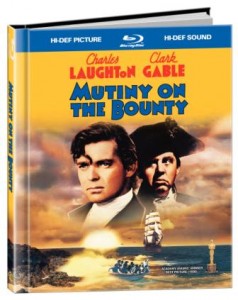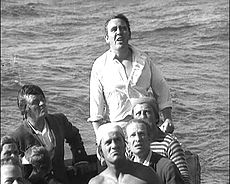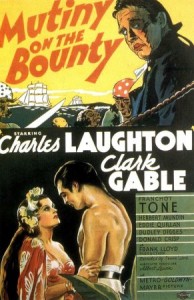
Clark Gable as the daring mutineer in the screen’s most exciting adventure story!
The mutiny on His Majesty’s Ship Bounty has been the stuff of lore for quite some time. The story has been filmed three times and copied countless others. The most recent version (and probably most historically accurate) was 1984’s The Bounty with Mel Gibson as Fletcher Christian and Anthony Hopkins as Bligh. Most known version is 1962’s epic, though ponderous at numerous times, Mutiny on the Bounty with Marlon Brando as Fletcher and Trevor Howard as Bligh. The first, and best version, is 1935’s Mutiny on the Bounty with Clark Gable as Fletcher and Charles Laughton as Bligh.
A smash in 1935, Mutiny on the Bounty solidified Gable as the star of the 1930s and resulted in numerous Academy Award Nominations, including not one, not two, but three nominations in the Best Actor category (for Gable, Laughton, and Franchot Tone) and a nomination as Best Picture. Sadly, the only win was for best picture, the only film to win Best Picture and no other Academy Award. In large part due to the numerous Best Actor nominations from the film the Best Supporting Actor category was started the following year. A nominee not from Bounty in the Best Actor category, Victor McLaglen, won for his role in John Ford’s The Informer.
Although Gable went on to be the bigger star, the picture belongs to Laughton, who not only gets top billing but truly dominates the picture. Having lost countless pounds in an attempt to mimic the physical attributes of the historical Bligh, Laughton’s characterization is powerful and enigmatic without being over the top.
Frank Lloyd does an admirable job directing and although obviously much of the footage was not shot on location we still get the feel of being on a Royal Navy ship.
Gable, who incidentally resisted taking the role very strongly (he felt it would damage his masculine image), later would call this his best role. Gable as well gave a nod to historical accuracy, shaving his famous mustache as they were not permitted in the Royal Navy at the time. Gable’s portrayal is masterfully subtle is response to the ogre that is Laughton’s Bligh. This is nothing like the overboard presentation Brando gives in the middle version.
In terms of a brief synopsis, which probably is completely unnecessary though based on historical fact, is that a British ship is off on a two year voyage to Tahiti to pick up breadfruit for the West Indies. At the time the breadfruit was thought of as a potential cheap food source for slave labor. Fletcher Christian is the first mate to Captain Bligh. As the voyage progresses, Bligh becomes increasingly demanding and tyrannical. Shortly after departing from an extended stay in Tahiti, the crew, led by Christian, mutinies and sets Bligh and those of the crew still in his camp adrift in the ship’s boat.
 Historically we may never know how much of this is accurate. The ship’s log shows Bligh as much more magnanimous and forgiving than other Captains would have been in similar situations. Bligh ultimately was exonerated by a court of inquiry. The mutineers went off to Pitcairn Island with all but two meeting untimely demises. By the time the island and the mutineers were rediscovered John Adams was the only surviving mutineer. After reaching a peak population of over 200 today the population of Pitcairn Island is roughly 50 people, all still descended from the original mutineers.
Historically we may never know how much of this is accurate. The ship’s log shows Bligh as much more magnanimous and forgiving than other Captains would have been in similar situations. Bligh ultimately was exonerated by a court of inquiry. The mutineers went off to Pitcairn Island with all but two meeting untimely demises. By the time the island and the mutineers were rediscovered John Adams was the only surviving mutineer. After reaching a peak population of over 200 today the population of Pitcairn Island is roughly 50 people, all still descended from the original mutineers.
There are two firsthand accounts of the events of the mutiny, being Bligh’s memoir and that of one of the mutineers. Bligh may well not have been so depraved nor may Fletcher have been so pious. What is beyond doubt is that Bligh was highly regarded as a seaman at the time (ultimately reaching the rank of Admiral), although unfortunately his career was blemished by involvement in three mutinies. His navigational abilities (learned while in service with the great Captain Cook) set him as perhaps one of the greatest navigators in history. With this launch and 18 men he navigated successfully over 3,600 miles to the port of Timor, then the nearest European settlement –with the loss of only one man due to a native attack.
 The Mutiny on the Bounty has been out, as have all these classics coming to blu-ray in the current surge from Warner Brothers, on standard DVD forever. Again the pressing question is (and yes we are surely being redundant by now) should you invest the money in the upgrade? Mutiny on the Bounty hits the streets on November 16.
The Mutiny on the Bounty has been out, as have all these classics coming to blu-ray in the current surge from Warner Brothers, on standard DVD forever. Again the pressing question is (and yes we are surely being redundant by now) should you invest the money in the upgrade? Mutiny on the Bounty hits the streets on November 16.
For purely supplemental features the answer is a resounding no. The on disc supplemental material here is paltry, especially for a film of this stature. The accompanying book (Bounty is presented in the elegant book format Warners seems to prefer) is where there is a lot of good archival photos along with some well done commentary as well. Video quality is good, and perhaps as good as can be expected for a film of this age.